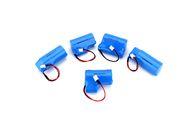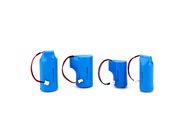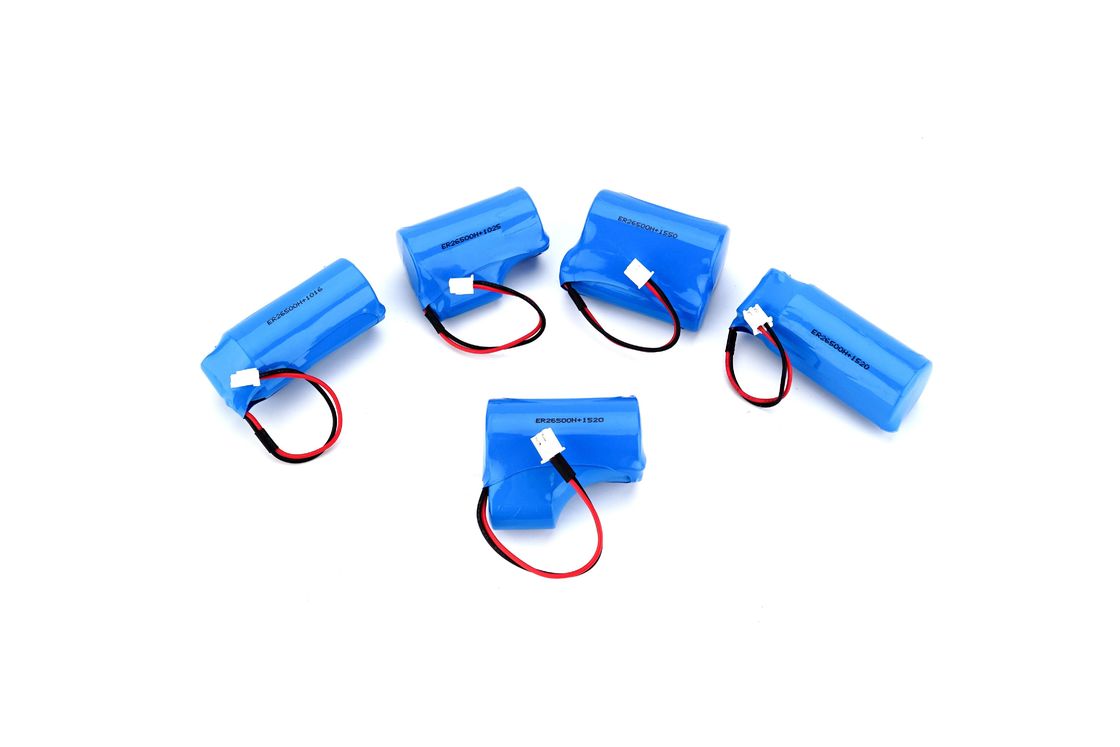Li-SOCl2 Battery+SLC Model ER34615H+SLC1550 for IOT LPWAN solution ; ETC; water meter
Product Specification
Li-SOCl2 Battery+SLC
Model:ER34615H+SLC1550
The document applies to ER34615+SLC1550 (Li/SOCl2) battery pack supplied by MAXPOWER Specify quality, test method, performance, quality assurance and matters need attention etc..
Lithium Thionyl Chloride + Super Lion-Capacitor
Table 1
| No. |
Item |
Characteristic |
Remarks |
| 1 |
Type |
ER34615+SLC1550 |
Bobbin type battery (ER34615)
Lithium-ion battery capacitor (SLC1550)
|
| 2 |
Nominal
Voltage
|
3.6V |
Tested with 36KΩ/0.1mA load at +20±5℃ |
| 3 |
Nominal capacity |
19Ah |
At 1.8kΩ/2mA load, 2.0V cut off, +20±5℃ (the actual measured capacity value will be changed by discharge current, teerature and cut-off voltage) . |
| 4 |
Operating teerature |
-40℃~+85℃ |
Operation under higher teerature than ambient teerature may lead to reduced capacity and lower voltage reading at the beginning of pulses. If continuous high teerature over +40℃ or low teerature down to -20℃ usage conditions, please consult EVE. |
| 5 |
Outside dimensions |
/ |
Please ref. to the production drawing |
| 6 |
Nominal weight |
About 120g |
|
4.Appearance
4.1 Appearance
Cell appearance, no scratch, swelling, deformation, corrosion, electrolyte leakage and other defects.
4.2 Mark and label
4.2.1 Mark
The battery label contains the following: model, type, coany name, voltage, positive and negative mark, safety warning content, certificaiton mark, no littering sign.
4.2.2 Manufacture date
DD/MM/YY print on battery sleeve.
eg:DD/MM/YY:DD-day, MM-month, YY- year.
5. Typical electrical performances
| No. |
Item |
Characteristic |
Remarks |
| 1 |
Max. Pulse current/mA |
2000 |
@23±5℃,1s open/1s close |
| 2 |
Pulse discharge voltage |
3.20V |
2.0A, discharge 1s, 20±5℃ |
| 3 |
Leakage current@RT |
<5μA |
<30℃ |
| 4 |
Leakage current@HT |
<15μA |
60~80℃ |
6.Inspection items, order, saling method and capacity judgment basis
6.1 Inspection items, order, saling method
Table 3
| No. |
Item |
Saling(GB2828.1.2012) |
| QC level |
AQL |
|
| 6.1 |
Open voltage |
Ⅱ |
0.065 |
|
| 6.2 |
Load voltage |
Ⅱ |
0.065 |
|
| 6.3 |
Appearance |
Ⅱ |
1.0 |
|
| 6.4 |
Dimension |
S-1 |
1.0 |
|
| 6.5 |
Capacity |
As destructive testing, the customer can determine on the basis of the actual situation |
|
Note: Unless other specified, the above items should be tested within 45 days since receipt of the battery
6.2 capacity judgment
6.2.1 If the average capacity is not less than the standard value specified in Table 2, and no battery below 90% of the value, the battery capacity is qualified.
6.2.2 If the average capacity is lower than the standard value specified in Table 2, and some battery below 90% of the value, do re-sale test, If the average capacity is not less than the standard value specified in Table 2, and no battery below 90% of the value, the battery capacity is qualified.
6.2.3 if the average capacity is lower than the standard value specified in Table 2 and some battery below 90% of the value during the second test, the battery capacity is unqualified.
7.Safety and environmental performance
7.1 Environmental performance
7.1.1 Heating cycle test
Batteries are placed in a test chamber and subjected to the following cycles:
a= 30min raise to 70±3℃, maintaining 4h.
b= 30min release to 20±3℃, maintaining 2h.
c= 30min release to -40±3℃, maintaining 4h.
d= 30min release to 20±3℃.
e=Repeating the sequence for a 9cycles.
f= after 10 cycles, battery be static placed for 7 days.
Pass/Fail criteria: the sales shall not explode or catch fire. In addition, the sales shall no leakage.
7.1.2 Altitude Simulation
sale batteries are to be stored for 6h at an absolute pressure of 11.6KPa(1.68psi) and a teerature of 20±3℃(68±5°F)
Pass/Fail criteria: The batteries shall be no explosion or catch fire as a result of the altitude simulation test. In addition the sales shall be no vent or leakage.
7.1.3 Fall test
cell drop from 1.9m height onto cement ground (total 10 times).
Pass/Fail criteria: The battery sales shall be no explosion or catch fire. In addition, the sales shall no vent or leakage.
7.1.4 Vibration test
battery vibration frequency is to be varied at the rate of 1 hertz per minute between 10 and 55 hertz, and return in not less than 90 or more than 100 minutes. test in three mutually perpendicular directions
Pass/Fail criteria: The battery sales shall be no explosion or catch fire. In addition, the sales shall no vent or leakage.
7.2 Safety test
7.2.1 heating
Battery is heated in a gravity convection or circulating air oven. The teerature of the oven is to be raised at a rate of 5±3℃ per minute to a teerature of 130±2℃ and remain for 10 minutes at that teerature before the test is discontinued.
Pass/Fail criteria: The battery sales shall be no explosion or catch fire.
7.2.2 Iact
A test sale cell was placed on a flat surface. A 5/8 in. (15.8 mm) diameter steel bar was placed across the center of the sale. The length of the bar should be at least as long as the width of the sale. A 20 pound (9.1 kg) weight was dropped from a height of 24 ± 1 in. (610 ± 25 mm) on to the sale.
Pass/Fail criteria: The sales shall not explode or catch fire.
7.2.3Crush test
A cell was crushed between two flat hard surfaces (i.e. steel). The crushing was continued until a force of 3000 pounds (13kN±0.78kN) was applied by hydraulic piston with a diameter of 32mm. press continue until pressure reach up to 17.2a. Once the maximum pressure was obtained, it was released.
Pass/Fail criteria: The battery sales shall be no explosion or catch fire.
7.2.4 forced discharging
a coletely discharged cell is to be force-discharged by connecting it in series with fully charged cells of the same kind. The number of fully charged cells to be connected in series with the discharged cell is to equal the maximum number less one of the cells to be covered for series use, the circuit load resistance less than0.1Ω. The sale is to discharge until a fire or explosion is obtained, or until it has reached a coletely discharge state of less than 0.2V and battery case teerature has returned to ±10℃(+18ºF) of ambient teerature.
Pass/Fail criteria:The sales shall be no explosion or catch fire.
7.2.5 External Short-circuit
Connect the battery positive and negative terminal with Cu wire(internal resistance < 0.1 ohm), battery was discharged until a fire or explosion was obtained, or until it had reached a coletely discharged and the cell case teerature had returned to ambient teerature.
Pass/Fail criteria: The battery sales shall be no explosion or catch fire.
7.2.6 forced recharging
Tested battery is subjected to a charging current of three times of the current specified by the manufacturer by connecting dc-power. The specified charging current is to be obtained by connecting a resistor of specified size and value.
The test time is calculated from the formula:
Tc=2.5*C/(3*Ic)
In which
Tc——charge time, hour, Tc≥7Hour;
C——Nominal capacity, Ah;
Ic——Max. charging current,mA. ER18505 maximum charge current is 0.015A.
Pass/Fail criteria:The sales shall be no explosion or catch fire.
8.Safety terms
8.1 Before use, do not remove the battery from the original packaging.
8.2 Do not scattered placed the battery together in order to avoid accidental short circuit.
8.3 Do not heat the battery above 100 ℃ or incinerated.
8.4 Do not recharge the battery.
8.5 Do not mixed with different brand, model or type batteries.
8.6 Do not mix the new and used batteries.
8.7 Do not disassembly or open battery.
8.8 Do not short circuit the battery or reversely contact the positive and negative terminals.
8.9 Do not solder on the battery surface.
8.10 Do not test environment and safety under extrusion without any protection.
8.11 Do not use or store batteries under wet conditions without protection.
8.12 Batteries are not allowed to be used excessively in the equipment without setting the cut-off voltage. After reaching the cut-off voltage, it should be removed from the equipment immediately to stop working.
8.13 Stop using if the battery is found to have heat, odor, discoloration, deformation, or other abnormalities during using or storage.
8.14 Batteries used should be handled in accordance with local environmental regulations and buried deep underground or into brine.
8.15 If the liquid is splashed on the skin, eyes and clothes, rinse immediately with plenty of water, and then seek medical care immediately.
8.Storage
9.1 Batteries should be used and stored away from static electricity
9.2 Batteries shall be stored not exceeding 30 DEG C and relative humidity of 45% - 75%.
9.3 Keep the battery away from the heat source, away from corrosive gas, avoid direct sunlight, and make sure the storage area is clean, cool, dry and ventilated.
9.4 The battery packing carton height shall not exceed 1.5 meters, and the wooden box shall not exceed 3 meters.
9.5 Batteries should keep the original storage state when not using, after removing the packaging, the battery should not be piled up irregularly.
10.Transportation
10.1 Battery meets the tests and criteria requirements of UN Manual, Part III, subsection 38.3.
10.2 Batteries should be protected against sunlight, fire, rain, immersion, and corrosive substances in transportation.
10.3 Handling and loading should be with care.
10.4 For long transportation, such as shipping, should be kept away from the engine. And in summer should not be prolonged in an airless environment.
11.Effective
11.1 Because the voltage passivation is the basic feature of lithium thionyl chloride battery, if the batteries will not install within 3 months, we suggest to activate the battery before using. please consult the MAXPOWER for activation scheme.
11.2 In practical applications, customer should be responsible for the coatibility and reliability of the battery and the device.
11.3 In any of the following circumstances, MAXPOWER will not take any responsibility: the client’s fails of appropriate treatment, operation, installation, testing, maintenance and inspection of the battery, or do not follow the instructions provided in the specification, notes, terms, and other MAXPOWER instructions.
11.4 This specification is accepted after 6 months from the date of issues if not be refunded.
12. Statement
If you have any questions on the product specifications, please contact with MAXPOWER . MAXPOWER . Reserves the right to amend the product specification.
13.Battery dimension



 Your message must be between 20-3,000 characters!
Your message must be between 20-3,000 characters! Please check your E-mail!
Please check your E-mail!  Your message must be between 20-3,000 characters!
Your message must be between 20-3,000 characters! Please check your E-mail!
Please check your E-mail! 


